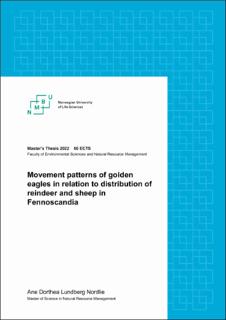| dc.description.abstract | Predator-livestock conflicts are a big problem worldwide, and usually result in big ethic and economic difficulties. Even though a lot of research has been done on the matter, there are still many uncertainties connected to the subject. For the golden eagle the main challenges are connected to the lack of information regarding territoriality, and how it affects depredation of livestock and both small- and large-scale movements. Territorial individuals, on the other hand, are believed to stay in their territory throughout the year without the ability to track resources over large spatial scales. Non-territorial individuals roam larger areas and are therefore believed to be the main tortfeasor on livestock, since they presumably are driven by food availability.
My thesis is based on data from nine eagles, three territorial and six non-territorial individuals, that carried GPS transmitters in a harness on their backs. The data has been collected through the NINA project called “Loss of lambs to Golden Eagles on the Fosen Peninsula,” a five-year-long project investigating the role of golden eagles in the loss of domestic sheep as well as the eagles’ diet and movement behavior. Home range size was estimated for the breeding- and non-breeding season for the territorial eagles. Upon finding that territorial individuals largely stay within or close to their breeding territories throughout the year, I continued investigating if patch residency time for the non-territorial individuals was affected by presence of reindeer and sheep. This was done on three different radii: 1000, 5000 and 10 000 meters. I hypothesized that both prey species are attractive for young golden eagles and that patch residency time would increase in their presence.
I found that two out of the three territorial individuals made small-scale movements during the non-breeding season. This could be explained by an abundance of prey at the location visited, as well as the need to recharge after an energy-demanding breeding period. For the non-territorial individuals, the patch residency analysis for all three radii revealed that the eagles tended to spend more time in patches with reindeer than without, but less time in patches with sheep present than without. An explanation could be a preference for reindeer over sheep. Reindeer is a prey type that can be found naturally in Norway, and therefore have been an available food source for a long period of time. Lastly, the results show large seasonal and individual variations in patch residency time. This could be explained by the fluctuations in the population of the eagles’ main prey species, hare, and ptarmigan. According to the alternative prey hypothesis, the depredation of livestock will increase when the access to the eagles’ main prey is low. This might explain the big monthly and yearly variations for each individual.
My study indicates that non-territorial golden eagles stay longer in an area if reindeer are present. Based on these results, I see culling as an unsuitable management measure, mainly because the patch residency within a 10 000-meter radius is as low as approximately eight days, but also because of large individual and temporal variation, making this result hard to generalize.
This thesis gives insight into the movement behavior of golden eagles and is relevant to future management, especially regarding the realism of catching the culprit doing the livestock damage. Going forward, it will be necessary to do more research on the subject to gather an even deeper understanding of movement behavior and motivations for the eagles, but also to move towards obtaining loss rates of reindeer and lambs in a range of study sites. | en_US |

